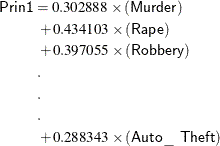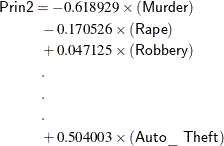The HPPRINCOMP Procedure
Getting Started: HPPRINCOMP Procedure
The following data provide crime rates per 100,000 people in seven categories for each of the 50 US states in 1977:
title 'Crime Rates per 100,000 Population by State';
data Crime;
input State $1-15 Murder Rape Robbery Assault
Burglary Larceny Auto_Theft;
datalines;
Alabama 14.2 25.2 96.8 278.3 1135.5 1881.9 280.7
Alaska 10.8 51.6 96.8 284.0 1331.7 3369.8 753.3
Arizona 9.5 34.2 138.2 312.3 2346.1 4467.4 439.5
Arkansas 8.8 27.6 83.2 203.4 972.6 1862.1 183.4
California 11.5 49.4 287.0 358.0 2139.4 3499.8 663.5
Colorado 6.3 42.0 170.7 292.9 1935.2 3903.2 477.1
Connecticut 4.2 16.8 129.5 131.8 1346.0 2620.7 593.2
Delaware 6.0 24.9 157.0 194.2 1682.6 3678.4 467.0
Florida 10.2 39.6 187.9 449.1 1859.9 3840.5 351.4
Georgia 11.7 31.1 140.5 256.5 1351.1 2170.2 297.9
Hawaii 7.2 25.5 128.0 64.1 1911.5 3920.4 489.4
Idaho 5.5 19.4 39.6 172.5 1050.8 2599.6 237.6
Illinois 9.9 21.8 211.3 209.0 1085.0 2828.5 528.6
Indiana 7.4 26.5 123.2 153.5 1086.2 2498.7 377.4
Iowa 2.3 10.6 41.2 89.8 812.5 2685.1 219.9
Kansas 6.6 22.0 100.7 180.5 1270.4 2739.3 244.3
Kentucky 10.1 19.1 81.1 123.3 872.2 1662.1 245.4
Louisiana 15.5 30.9 142.9 335.5 1165.5 2469.9 337.7
Maine 2.4 13.5 38.7 170.0 1253.1 2350.7 246.9
Maryland 8.0 34.8 292.1 358.9 1400.0 3177.7 428.5
Massachusetts 3.1 20.8 169.1 231.6 1532.2 2311.3 1140.1
Michigan 9.3 38.9 261.9 274.6 1522.7 3159.0 545.5
Minnesota 2.7 19.5 85.9 85.8 1134.7 2559.3 343.1
Mississippi 14.3 19.6 65.7 189.1 915.6 1239.9 144.4
Missouri 9.6 28.3 189.0 233.5 1318.3 2424.2 378.4
Montana 5.4 16.7 39.2 156.8 804.9 2773.2 309.2
Nebraska 3.9 18.1 64.7 112.7 760.0 2316.1 249.1
Nevada 15.8 49.1 323.1 355.0 2453.1 4212.6 559.2
New Hampshire 3.2 10.7 23.2 76.0 1041.7 2343.9 293.4
New Jersey 5.6 21.0 180.4 185.1 1435.8 2774.5 511.5
New Mexico 8.8 39.1 109.6 343.4 1418.7 3008.6 259.5
New York 10.7 29.4 472.6 319.1 1728.0 2782.0 745.8
North Carolina 10.6 17.0 61.3 318.3 1154.1 2037.8 192.1
North Dakota 0.9 9.0 13.3 43.8 446.1 1843.0 144.7
Ohio 7.8 27.3 190.5 181.1 1216.0 2696.8 400.4
Oklahoma 8.6 29.2 73.8 205.0 1288.2 2228.1 326.8
Oregon 4.9 39.9 124.1 286.9 1636.4 3506.1 388.9
Pennsylvania 5.6 19.0 130.3 128.0 877.5 1624.1 333.2
Rhode Island 3.6 10.5 86.5 201.0 1489.5 2844.1 791.4
South Carolina 11.9 33.0 105.9 485.3 1613.6 2342.4 245.1
South Dakota 2.0 13.5 17.9 155.7 570.5 1704.4 147.5
Tennessee 10.1 29.7 145.8 203.9 1259.7 1776.5 314.0
Texas 13.3 33.8 152.4 208.2 1603.1 2988.7 397.6
Utah 3.5 20.3 68.8 147.3 1171.6 3004.6 334.5
Vermont 1.4 15.9 30.8 101.2 1348.2 2201.0 265.2
Virginia 9.0 23.3 92.1 165.7 986.2 2521.2 226.7
Washington 4.3 39.6 106.2 224.8 1605.6 3386.9 360.3
West Virginia 6.0 13.2 42.2 . 597.4 1341.7 163.3
Wisconsin 2.8 12.9 52.2 63.7 846.9 2614.2 220.7
Wyoming . 21.9 39.7 173.9 811.6 2772.2 282.0
;
The following statements invoke the HPPRINCOMP procedure, which requests a principal component analysis of the data and produces Figure 13.1 through Figure 13.4:
proc hpprincomp data=Crime; run;
Figure 13.1 displays the "Performance Information," "Data Access Information," "Model Information," "Number of Observations," "Number of Variables," and "Simple Statistics" tables.
The "Performance Information" table shows the procedure executes in single-machine mode—that is, the data reside and the computation is performed on the machine where the SAS session executes. This run of the HPPRINCOMP procedure took place on a multicore machine with four CPUs; one computational thread was spawned per CPU.
The "Data Access Information" table shows that the input data set is accessed with the V9 (base) engine on the client machine where the MVA SAS session executes.
The "Model Information" table identifies the data source and shows that the principal component extraction method is eigenvalue decomposition, which is the default.
The "Number of Observations" table shows that of the 50 observations in the input data, only 48 observations are used in the analysis because some observations have incomplete data.
The "Number of Variables" table indicates that there are seven variables to be analyzed and seven principal components to be computed. By default, if the VAR statement is omitted, all numeric variables that are not listed in other statements are used in the analysis.
The "Simple Statistics" table displays the mean and standard deviation of the analysis variables.
Figure 13.1: Performance Information and Simple Statistics
Figure 13.2 displays the "Correlation Matrix" table. By default, the PROC HPPRINCOMP statement requests that principal components be computed from the correlation matrix, so the total variance is equal to the number of variables, 7.
Figure 13.2: Correlation Matrix Table
| Correlation Matrix | |||||||
|---|---|---|---|---|---|---|---|
| Variable | Murder | Rape | Robbery | Assault | Burglary | Larceny | Auto_Theft |
| Murder | 1.0000 | 0.6000 | 0.4768 | 0.6485 | 0.3778 | 0.0925 | 0.0555 |
| Rape | 0.6000 | 1.0000 | 0.5817 | 0.7316 | 0.7038 | 0.6009 | 0.3282 |
| Robbery | 0.4768 | 0.5817 | 1.0000 | 0.5452 | 0.6200 | 0.4371 | 0.5787 |
| Assault | 0.6485 | 0.7316 | 0.5452 | 1.0000 | 0.6082 | 0.3791 | 0.2520 |
| Burglary | 0.3778 | 0.7038 | 0.6200 | 0.6082 | 1.0000 | 0.7932 | 0.5390 |
| Larceny | 0.0925 | 0.6009 | 0.4371 | 0.3791 | 0.7932 | 1.0000 | 0.4246 |
| Auto_Theft | 0.0555 | 0.3282 | 0.5787 | 0.2520 | 0.5390 | 0.4246 | 1.0000 |
Figure 13.3 displays the "Eigenvalues" table. The first principal component accounts for about 57.8% of the total variance, the second principal component accounts for about 18.1%, and the third principal component accounts for about 10.7%. Note that the eigenvalues sum to the total variance.
The eigenvalues indicate that two or three components provide a good summary of the data: two components account for 76% of the total variance, and three components account for 87%. Subsequent components account for less than 5% each.
Figure 13.3: Eigenvalues Table
| Eigenvalues of the Correlation Matrix | ||||
|---|---|---|---|---|
| Eigenvalue | Difference | Proportion | Cumulative | |
| 1 | 4.045824 | 2.781795 | 0.5780 | 0.5780 |
| 2 | 1.264030 | 0.516529 | 0.1806 | 0.7586 |
| 3 | 0.747500 | 0.421175 | 0.1068 | 0.8653 |
| 4 | 0.326325 | 0.061119 | 0.0466 | 0.9120 |
| 5 | 0.265207 | 0.036843 | 0.0379 | 0.9498 |
| 6 | 0.228364 | 0.105613 | 0.0326 | 0.9825 |
| 7 | 0.122750 | 0.0175 | 1.0000 | |
Figure 13.4 displays the "Eigenvectors" table. From the eigenvectors matrix, you can represent the first principal component, Prin1, as a linear combination of the original variables:

Similarly, the second principal component, Prin2, is

where the variables are standardized.
Figure 13.4: Eigenvectors Table
| Eigenvectors | |||||||
|---|---|---|---|---|---|---|---|
| Variable | Prin1 | Prin2 | Prin3 | Prin4 | Prin5 | Prin6 | Prin7 |
| Murder | 0.30289 | -0.61893 | 0.17353 | -0.23308 | 0.54896 | 0.26371 | 0.26428 |
| Rape | 0.43410 | -0.17053 | -0.23539 | 0.06540 | 0.18075 | -0.78232 | -0.27946 |
| Robbery | 0.39705 | 0.04713 | 0.49208 | -0.57470 | -0.50808 | -0.09452 | -0.02497 |
| Assault | 0.39622 | -0.35142 | -0.05343 | 0.61743 | -0.51525 | 0.17395 | 0.19921 |
| Burglary | 0.44164 | 0.20861 | -0.22454 | -0.02750 | 0.11273 | 0.52340 | -0.65085 |
| Larceny | 0.35634 | 0.40570 | -0.53681 | -0.23231 | 0.02172 | 0.04085 | 0.60346 |
| Auto_Theft | 0.28834 | 0.50400 | 0.57524 | 0.41853 | 0.35939 | -0.06024 | 0.15487 |
The first component is a measure of the overall crime rate, because the first eigenvector shows approximately equal loadings
on all variables. The second eigenvector has high positive loadings on the variables Auto_Theft and Larceny and high negative loadings on the variables Murder and Assault. There is also a small positive loading on the variable Burglary and a small negative loading on the variable Rape. This component seems to measure the preponderance of property crime compared to violent crime. The interpretation of the
third component is not obvious.
